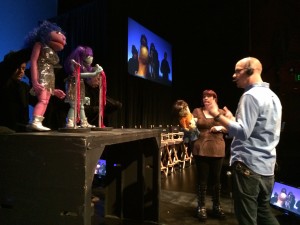Creative Mondays #009 – Seize the moment. Or regret it later.
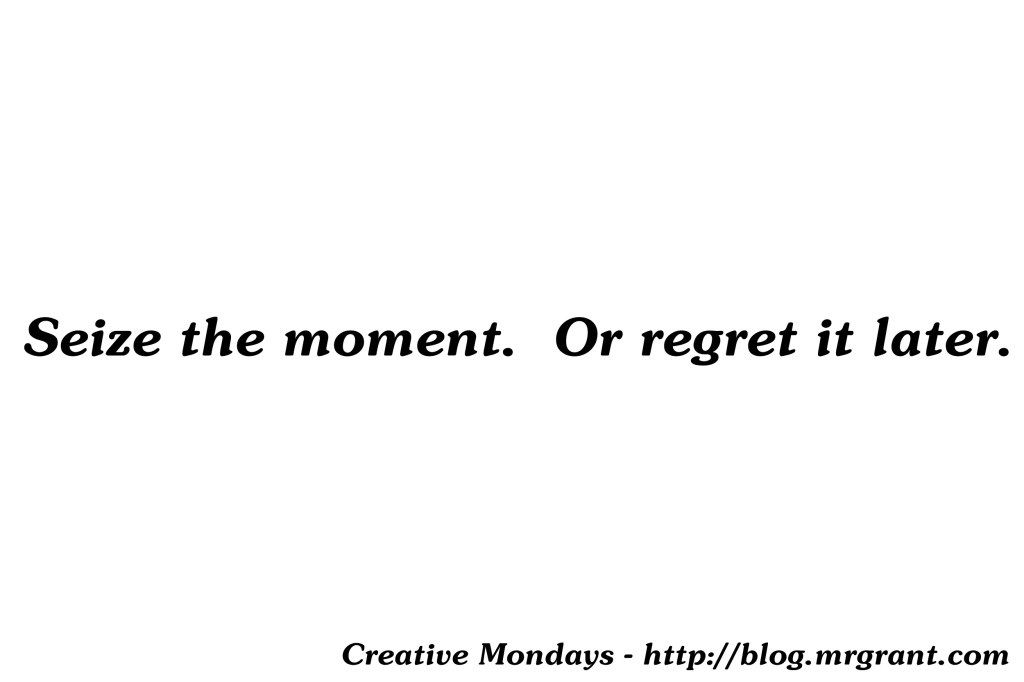
When I first thought about the topic for today’s post, I figured this would only work for those who are in the performing side of the creative arts world. But the more I thought about it, the more I feel it applies to everyone in the art world and, heck, everyone in general. Again, it’s a saying we have all heard a million times, but it bears repeating:
Seize the moment. Or regret it later.
This has rumbled back around in my brain this past week because I failed to seize a moment presented to me this past week and I’m totally regretting it now. Let my tale be a lesson to you all.
As you may or may not know, I am a ringside interviewer for Championship Wrestling from Hollywood. It is a totally fun job with a great group of people and last Sunday (February 23) I worked the latest round of TV Tapings for the show.
Before the show I found out that we would only have one permanent commentator for the day, the fantastic Johnny LaQuasto. He would be joined periodically on commentary by manager Stu Stone, but for the most part, he would be on his own. During the tapings, I sit next to the commentators table to ring the bell for the start and finish of each match and to be able to hop down to ringside to conduct the interviews. So I’m very close to the ‘action.’
Before we started the show, Stu Stone took me aside and said, “Listen, I have to be ringside for a lot of the matches and LaQuasto will be on his own. Hop on to commentary when I’m not there.” I nodded and said, “Okay.”
Now, I have never done commentary before. I had thought about it, yes, but never have I stepped up to the mic to actually call a match. My brain started tumbling with thoughts, “Yeah, you should totally do it. But what if I suck? Well, then they’ll never have you do it again, but you aren’t going to kill anyone by doing it. But I know I will suck.” The old negative brain hard at work.
The show started and Johnny and Stu were on commentary and soon Stu was off to head to ringside. I put on the extra headset (earphones and a mic) and sat there and…I didn’t say anything. Not that I was prompted to, Johnny was doing just fine solo. But in my head I felt, “I don’t really have the okay from someone in charge to do this so I’m not going to say anything. Plus, I’ve never done it so I’ll probably be bad at it.”
At one point during a match, Stu came past the table while running around the ring and yelled at me, “Why aren’t you saying anything?!” I laughed, but deep down I knew he was right. I should just start talking. Stu Stone is one of the best managers working the ‘indy’ wrestling world today. He got to that position by seizing EVERY opportunity that came his way.
So I sat there, pretty much the whole taping, with the headset on and I didn’t say a word. Because my brain was telling me that I’d be bad at it and I had this fear that I would ‘get in trouble.’
Days after I’m still regretting that decision for several reasons. First of all, I wouldn’t have been ‘bad’ at doing commentary during the match. I wouldn’t have been the next coming of Jim Ross by a long shot, but I wouldn’t have been as ‘bad’ as my brain had me convinced. I’m a strong improviser, I’ve been watching wrestling since 4th grade and I know all the guys in the ring. I could have done it. And, besides, if my commentary had been REALLY bad, I would have realized and I could have just dropped out at the end of the current match and not done it again. No biggie.
Secondly, I wouldn’t have ‘gotten in trouble.’ I wouldn’t have been fired or drummed out of wrestling. The worst case scenario is that Dave Marquez, our director and executive producer, would have just told me not to do it again. But again, knowing Dave, that would have only been if I would have been miserably bad, which we already have stated I wouldn’t have been. Had I seized the chance and it had been halfway decent, it would have shown to Dave and the other producers of the show that there is another place I can be plugged in during the shows.
I should have seized the opportunity. Now I just regret it.
Don’t let this happen to you. If you get the opportunity, seize it. Or regret it later.
—
Okay, let’s hear about the opportunities you failed to grab hold of. Why didn’t you jump? What did you learn from not seizing the chance to do something?
Puppet Up at The Kirk Douglas Theatre – Recap

I was very fortunate to be involved in three Puppet Up! Uncensored shows at the Kirk Douglas Theatre in Culver City, CA this past Thursday through Saturday. While I did write individual blogs on each of these nights, I’ve decided not to publish them. Instead I’m just going to do this post that will wrap up the experience. The reason I’m not publishing them is just because these were local shows, we were trying out new things and there were some things in the individual blogs that I just didn’t feel like putting out there. You’ll get a nice overview here, if you continue to read on.
Our three shows were at the Kirk Douglas Theatre. It’s a beautiful space with a great stage. Unlike other stages we’ve performed in, this one was on the ground floor and the seats were raked at a step angle. The thing I liked about this was that the audience was right there, at the lip of the stage. Sometimes I feel a big space between the stage and the audience, say for an orchestra pit, will cause a dip in the audience enjoyment. This is especially true with comedy. In comedy clubs no one wants to sit up front because they thing the comedians will pick on them. I’ve performed several places where the whole front will be empty and this will make it harder for the comedians to connect with the audience. This was not that case at the Kirk Douglas. And as a side note, the crew and staff at the Kirk Douglas are just amazing. Such a pleasure to work with them all.
The fan base for puppet improv is alive and well in Southern California as the shows sold out almost immediately. It really was spectacular how quickly the tickets went. Each house was just filled with people who were rabid for some puppet anarchy and we gave it to them.
The puppeteer who was sick was fine the next day. Just a weird bug. All is well.
– Thursday, February 20, 2014 –
The Thursday show was interesting. We had rehearsed the show with six puppeteers but just minutes before the show,one of the puppeteers became ill and was not able to go on. Being an improv show, we improvised! We, quickly, re-blocked the opening and then hit the stage. It was a wild night and I got to fill in so many great spots. Lady Singer on Face, Big Java in Java, I got to use the Henson Digital Puppetry Studio in that scene. A lot of fun. Moment of the night, for me, was right after performing Big Java and crossing to my chair, Brian Henson, who was also filling in here and there in spots had a big smile on his face and was laughing and he shook my hand and said, “that was great.” Pretty amazing.
I also got to do my favorite structure, Alien Barbershop. The topic was: umbrella. Yes, that was it. I went for it though.
Take an umbrella
They always warn ya
But I don’t have one,
I’m from southern California.
Not much of a hilarious joke. It got a good laugh but I was more proud of my rhyme for California.
The cast this night was the cast that will be headed to Australia in March. Australia, you have been warned, the puppets are coming.
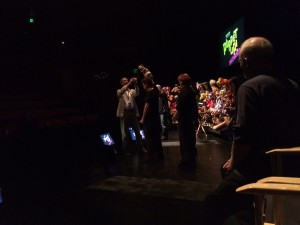
– Friday, February 21, 2014 –
The Friday night show was different in that I was slated to host this show. The cast was a ‘mix and match’ cast of really amazing puppeteers and improvisers and it was my job to lead them all though the evening. The show went really well. The puppeteers were all fantastic andthere was some super funny stuff. Everyone said I did great as the host. I’m much harder on myself though. Being the host of this show is really complex and it’s a tribute to Patrick that he handles it so easily. There is so much you have to keep track of and looking back I realized that while I did a good job as the host, it wasn’t GREAT because I wasn’t having fun. I needed to relax, not worry so much, trust everything was going to be fine and just have fun. It’s something I look forward to as we head out on the short US tour before Australia where I will get to host four of the five shows.
– Saturday, February 22, 2014 –
This show was amazing. From top to bottom. The audience was amazing and our improv and puppetry was fantastic. It was a great group of puppeteers I was honored to perform with. Each scene was really high quality and the puppetry was amazing. Our version of WINDY that night was one of the best I’ve seen. Victor’s Usher bit to open act 2 is out of this world. And the show was just really amazing.
I made my Little Java debut and it went well. I really need to study the original because I feel there’s some beats I’m missing and I need to find out what they are in order to really hit the comedy right.
Also got to do the Alien Barbershop again and it may be my favorite of all time. The topic was Children’s Fight Club. My rhyme:
The children in Fight Club
Are as tough as shit.
They beat each other up
But they don’t talk about it.
It killed.
Another highlight of this show was getting to do the job interview/audience participation bit with Brian Henson. So much fun.
The whole show was just fantastic and I’m excited to be headed out with this cast on the mini-US tour.
So three fun shows here in Southern California. A lot of people said they wished we were running longer, so who knows? Maybe there will be more during the summer.
Every time I get to do this show I say it is the most fun thing I get to do. And it is. And I am unbelievably lucky that I get to do it.
And I can’t wait to do it again.
Creative Mondays #008 – Create a Catalog of Ideas.
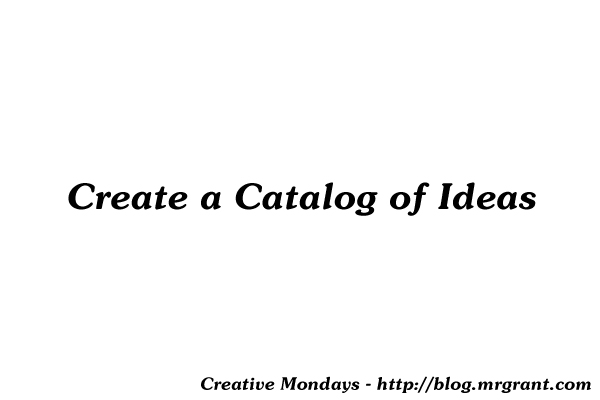
Here is the third installment of creative ideas I took away from seeing Joel Hodgson’s talk “Riffing Myself” in Northern California recently. I highly recommend going to see this show, even if you aren’t a fan of Mystery Science Theatre 3000. It’s a great show for anyone who is creative and, to me, gives great insight on how things, great things like Mystery Science Theatre 3000, are created. You can read the previous two blogs here: Don’t do what you don’t want to do & Nothing ever comes out done.
This final topic is actually a topic that I already have written on and was scheduled to come up soon here on the blog. I may touch upon it again in upcoming weeks, but I really waned to use Joel’s talk as a springboard to write on this idea. The idea of a creative idea book.
Joel told the story of taking a sculpture class in college where the instructor made all the students buy a big, black, hardbound sketch journal to use in the class. Joel thought the idea was a bit pretentious in that he felt he didn’t have any ideas worth putting into a hardbound journal, but it was a requirement so he picked one up. In his talk, Joel actually shows scans of the first two pages of the journal they are filled with ideas for different sculptures. Then he shows a scan of the third page where there are sculpture ideas on the top of the page and below is an, almost comical, mock up of a trick Joel wanted to create for his magic act. He then goes on to show other pages and, never again, were any of the pages adorned with sculpture ideas. From that page on it was ideas for things Joel wanted to create.
Joel calls this his Catalog of Ideas. He likens it to the old magician’s catalog he loved thumbing through as a kid. Full of wondrous things. Possibilities. Things that may happen of may not. His Catalog of Ideas was a storehouse of thoughts on things to create. Some he acted on immediately. Others lay dormant on the page, perhaps to be acted on in the future. He also spoke how, a lot of times, several different ideas in the Catalog would be combined together to create something completely different from anything else. He wrapped this part of the speech up by showing a picture of a closet, I’m assuming, in his office that is now full of large, black, hardbound sketch journals. His catalog of ideas. (Side Note: If you’re as big a fan of Joel’s as I am, wouldn’t you just love to thumb through those?)
So, a Catalog of Ideas. I have to admit, I don’t really keep one like the one Joel mentions in his talk. I think Joel is a lot more visual than I am where I prefer to write things out. Most times if I have an idea I will type it into the notes on my phone. Or I’ll just let it rattle around in my head until it’s so big I just have to act on it. I have recently been keeping a sort of idea journal. It has some ideas but it also has notes from meetings and classes, so it’s not strictly an idea journal. But you know what? I’m going to take it as a challenge to start a Catalog of Ideas of my own. I’ll let you know how it goes.
Again, I will plug Joel’s show. Go see it. For info visit his website here – www.JoelHodgson.com
—
Do you keep your own Catalog of Ideas? If so, how long have you done it? Tell us about it in the comments below. If you don’t keep one, how do you store all your creative ideas? Again, let me know below.
Creative Mondays #007 – Nothing ever comes out done
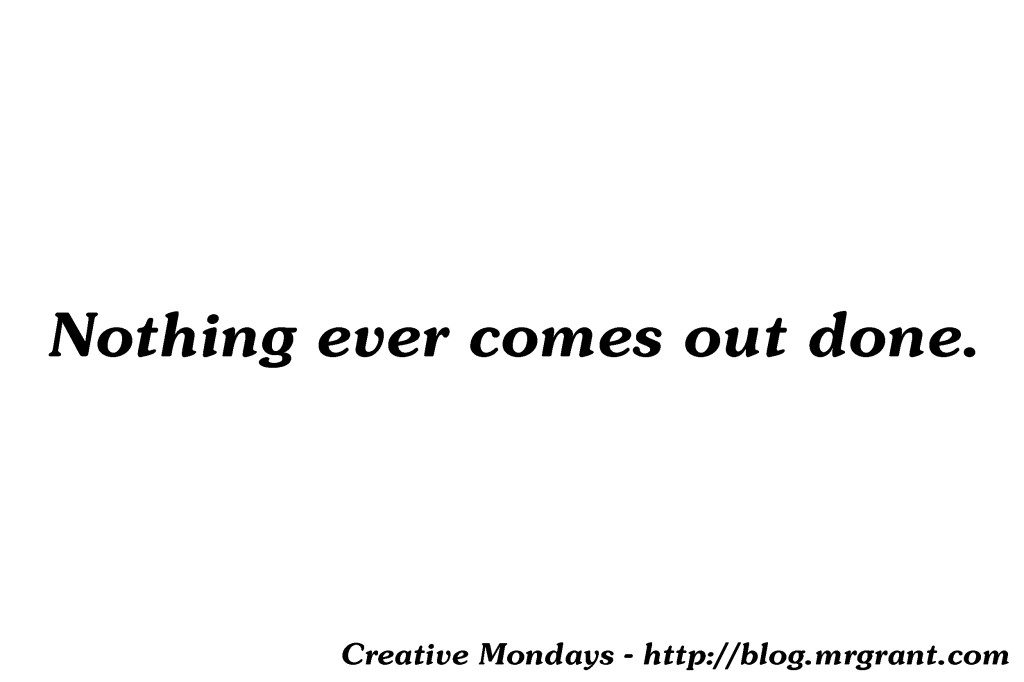
Last week I wrote about the concept of: Don’t do what you don’t want to do. It was an idea that had struck me when I went to see Joel Hodgson’s Riffing Myself show last weekend. I had two more thoughts from that show and I want to touch on the next one this week.
During Joel’s show he spoke a lot about the things that influenced him growing up as a kid. He talked about being captivated by the artwork of Roger Dean. If you don’t know, Roger Dean was an artist who is probably best known for doing the artwork for the covers of several albums for the band Yes. Those far out, alien looking, landscapes? Those were by Roger Dean. When Joel was younger Roger Dean released a book called Visions. It collected a bunch of artwork to that point in his career, but not only did the book include the artwork, it also showed the process of the artwork. From pencils sketches, through refinements, to the finished project, Roger showed step by step how things were made. Roger Dean also introduced Joel to the concept of kitbashing, or taking different parts from different model kits and combining them together to create something new. A technique Joel would later use to build robots for a certain television show.
One part of the book that really captured Joel’s attention was a page where Roger showed the process he took to create the logo for the band Yes. The swooping, sort of intertwined, logo that the band still uses to this day. That page, that showed the evolution of the logo from start to finish in a series of different photos of drawings was a lightbulb moment for Joel. Until that point, he had never realized that finished products aren’t just instantly created.
During his talk, Joel said the phrase, “If it’s not perfect, it’s not done.” I later talked to him about this statement and clarified clarified a bit saying that nothing comes out perfect the first time. It takes work to get something right. There’s a lot of trial and error in working to get something right.
I was happy for this clarification because the word ‘perfect’ opens up a lot of troubling doors, in my opinion. I’ll write about the ‘quest for perfection’ in the weeks to come. But the point Joel is making here is, as I said above, art just doesn’t come out perfect immediately.
If you’re writing a song, very rarely is it finished on first pass. Same with writing a book, play or script. Painting, sculpting, the list goes on. Creating art doesn’t just come out as a finished product.
I will take this stance however, it’s it okay to continue to create as you are refining your process. My example for that is my podcast The Radio Adventures of Dr. Floyd. If you listen to first season episodes and compare them to season eight episodes there is a world of difference. The pacing is tighter, the sound quality is better, it’s just an overall better show. That’s because there was a huge learning curve in how to edit and create an episode over those eight seasons. I learned a lot about editing audio and it shows. Also I think my writing improved from season one to season eight.
In sticking with the topic of ‘nothing comes out done,’ I wouldn’t say those season one episodes weren’t done. I worked on them just as hard as I did season eight episodes. I was just better at the work in those later years.
I think the takeaway here is that it takes some time to create art. Nothing ever comes out done
—
Is the idea of ‘nothing ever comes out done’ true in your creative work? How long does it take for you to finally say, “That’s done, I’m moving on to the next piece?” Let me know in the comments below.
